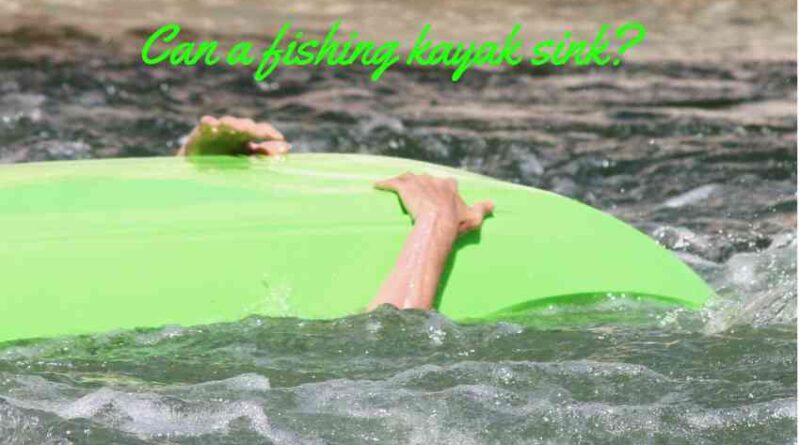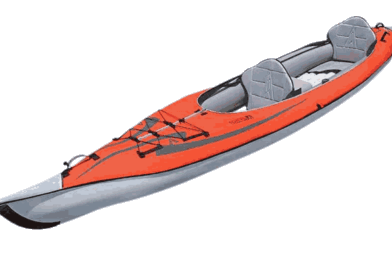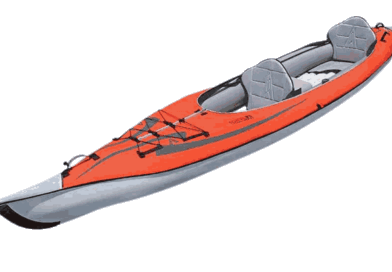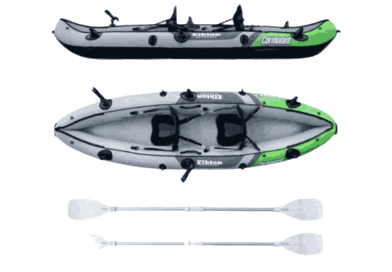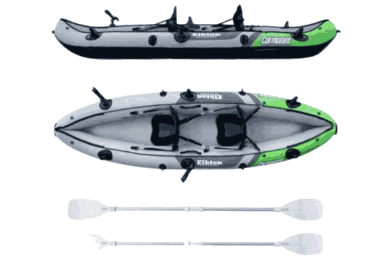Can a Fishing Kayak Sink? Answers to Your Burning Questions
Kayak Sinking 101: Answers to Your Burning Questions
Are you a beginner kayaker who’s worried about the safety of your fishing kayak? Or maybe you’re an experienced kayaker who’s curious about the science behind kayak sinking. Look no further because we’ve got you covered!
In this article, we’ll answer the most important questions about kayak sinking. From the weight limit to scupper plugs, shark attacks to preventing your kayak from sinking, we’ve got everything you need to know.
So sit back, grab your life jacket, and let’s dive into the world of kayak sinking!
Table of Contents
Can a Fishing Kayak Sink?
Sure, it can! But it depends on the type. Let me explain. Sit-on-top kayaks are like unsinkable ducks – they don’t have a big hollow space to fill with water. Even if you capsize, most of the water will just pour off when you flip it back over.
On the other side, sit-inside kayaks are more like bowls. If they flip, they can fill up with water and are more likely to sink. Imagine filling a bowl and a cup with holes in the bottom – which one do you think will float? That’s right, the cup! And in this case, the sit-on-top kayak is our cup!
Doesn’t that make you curious about what happens if you put too much weight in a kayak? Let’s dive into that next!
Will a Kayak Sink if You're Over the Weight Limit?
Have you ever tried carrying a backpack that’s too heavy? It’s tough, right? The same goes for a kayak. If it’s overloaded, paddling gets tougher and the kayak might wobble a bit, but it’s rare to sink. Picture yourself running with that heavy backpack – you’d slow down and might trip, but you won’t sink into the ground!
But, beware of big waves, as they might make more water splash into the kayak. So, always remember to check the kayak’s weight limit!
Now that we understand how weight affects a kayak, how about we look at something called scupper plugs next?
Will a Kayak Sink Without Scupper Plugs?
No, your kayak won’t sink without the plugs. You might be wondering what scupper plugs are. Well, think of them like the drain stopper in your bathtub. When the stopper is in, water stays in the tub. When it’s removed, water drains out. Similarly, if your kayak scupper plugs aren’t in place, any water that comes in will just flow back out.
It’s like having an automatic water-draining feature built into your kayak!
Ever heard of a Pelican kayak? Can it sink? Let's explore!
Do Pelican Kayaks Sink?
Pelican kayaks could potentially sink, especially the sit-inside models. These models, like the Pelican Argo 100X, can fill with water if they flip over because they don’t have bulkheads, which are like watertight doors in a ship. Imagine your house with all the doors open during a rainstorm, water would get everywhere, right?
Think for yourself what will happen with this kayak! (source: Pelican International)
But how often do kayaks really flip over? Let’s find out!
How Common is it for a Kayak to Flip?
Flipping a kayak is actually quite rare. Think of it like riding a bike. If you’re careful and on a calm path, you’re not likely to fall over. Kayaking is the same. Unless you’re in big waves or trying to do tricks, your kayak will likely stay upright, especially if it’s a recreational kayak.
But what if you keep tipping over in your kayak? Let’s investigate!
Why do I Keep Tipping Over in a Kayak?
Tipping over usually happens due to balance issues or unpredictable water conditions. Imagine when you first tried to ride a bike, you probably wobbled and maybe even fell a few times, right? Similarly, with kayaking, the more practice you get, the better your balance becomes, and the less likely you’ll tip over.
So, if you’ve been tipping over, don’t worry! It’s just part of the learning process.
Now that we’ve covered that, let’s address a question that might sound a bit scary – can a shark sink a kayak? Let’s dive in!
Can a Shark Sink a Kayak?
Shark attacks on kayaks are incredibly rare. But it’s always smart to be cautious. Just like you wouldn’t want to poke a sleeping bear, you wouldn’t want to disturb a shark. So, always respect marine life and stay calm if you see a shark.
Curious about how much weight it would take to sink a kayak? Read on!
How Much Weight Does it Take to Sink a Kayak?
The amount of weight it takes to sink a kayak varies depending on the type and size of the kayak. Generally, most kayaks can hold up to 250-300 pounds of weight without sinking. For instance, a Whitewater Kayak holds about 200-250 pounds, while an Inflatable Kayak can hold between 300-500 pounds.
| Kayak Type | Weight Capacity |
|---|---|
| Whitewater Kayak | 200-250 pounds |
| Inflatable Kayak | 300-500 pounds |
Ever wondered how shallow water can be for kayaking? Let’s find out!
How Shallow of Water Can a Kayak Go?
With a kayak, you can paddle in water that’s only 3-5 feet deep. Think of it like wading in a kiddie pool – you can still have fun, but you have to be careful not to scrape the bottom. But remember, this depth can change based on the type of kayak and your paddling skills.
What should you do if your kayak suddenly turns into a bathtub filled with water? Let’s learn about that next!
What if your kayak does fill up with water? Read on to discover what to do!
What to Do If Kayak Fills With Water?
If your kayak fills up with water, stay calm! If you’re near the shore, paddle towards it. Then, flip the kayak to empty out the water. If you’re not near the shore, use a bilge pump or a sponge to remove the water. Remember, always wear a life jacket for safety.
But will a kayak sink to the bottom? Keep reading!
Will a Kayak Sink to the Bottom?
Although kayaks are designed to stay afloat, they aren’t unsinkable. Imagine a kayak is like a floating toy in a bathtub. If it fills up with water, it can sink, especially if it’s carrying a load beyond its capacity. Also, if the kayak doesn’t have a proper water removal system, it could sink.
So, always remember to check everything before going out on the water.
Lastly, let’s find out how you can prevent your kayak from sinking. Keep reading!
How Do I Stop My Kayak from Sinking?
You can prevent your kayak from sinking by using a spray skirt. Imagine it as a super-hero cape for your kayak that helps keep water out. You wear it around your waist and attach it to the cockpit’s rim, just like a superhero wears a cape. It works to keep the water out, ensuring that your kayak doesn’t sink.
So, suit up and always use the right gear to enjoy a safe and fun adventure on the water!
This concludes our exciting journey into the world of kayaks. But remember, there’s always more to learn and explore! Happy kayaking!
Frequently Asked Questions:
What safety precautions should I take to prevent my kayak from sinking?
To prevent your kayak from sinking, make sure to follow weight limits, avoid overloading, and check for leaks or damages before each use.
What type of kayak is best for fishing to prevent sinking?
A sit-on-top kayak with a wide and stable base is generally the best option for fishing and preventing sinking.
Will a kayak sink if I'm overweight but within the weight limit?
Even if you’re within the weight limit, being overweight can increase the risk of sinking, so it’s important to choose the right kayak and distribute weight evenly.
How do I prevent wildlife from tipping over my kayak?
To prevent wildlife from tipping over your kayak, avoid getting too close and make sure to keep your belongings and food secured.
What are some tips for balancing and maneuvering a kayak to prevent sinking?
Balancing and maneuvering a kayak can take practice, but some tips include keeping your weight centered, using a low and stable paddle stroke, and avoiding sudden movements or excessive leaning.
What Can You Do Now?
Now that you know more about kayaks and their potential to sink, it’s important to always check the weight limit and use proper gear to prevent accidents. If you’re looking for a new kayak or want to upgrade your current one, check out our review of the 12 most demanded kayaks on the market. Happy kayaking!
Now that we’ve covered some common questions about kayak sinking in this article, let’s move on to another crucial aspect of kayaking – water drainage. In the next article, we’ll explore whether kayaks get water in them, how to drain them, and what to do if your kayak is filled with water.
So if you’re ready to learn more about this essential topic, let’s jump right in!
